Supporting materials
Script of the play (Word document)
Powerpoint presentation (PPT file)
Download
Download this article as a PDF

Imagine sending music across the room by laser. Sounds impossible, doesn’t it? But Alessio Bernardelli’s students did just that – and then developed a play to explain the science behind it. Here’s how to do it.

To encourage our Year 12 students (ages 16-17) not to consider everyday technology as a ‘black box’ but to ask themselves how it works, my colleagues and I asked them to research, design and build a modulated laser, based on a cheap commercial laser pen. When they found a plausible design, they were astonished at how simple it was. Even some of the teachers had doubted that it would work.
In fact, it exceeded all our expectations. Not only did the modulated laser send an audio signal across the room, the music received by the light sensor and played on the speaker was loud and clear. Our students were amazed that they had made something that they hadn’t even known was possible. In fact, it is quite a simple process and can be used to explain a wide range of physics topics – as our students did in the next stage of their project.
What I like about our device is that it is very cheap and very visual. You could buy a similar device for about £250, but ours cost about £15 to make. Also, you can see exactly how our device is constructed, so that even the least scientifically minded can see how the circuit is connected.
The input signal from the audio device is sent across a resistor. Because this signal is AC (alternating current), it causes variation in the voltage across the resistor, which in turn causes the overall current in the circuit to change with the same frequency as the input signal. This causes the intensity of light in the laser diode to change with the same frequency.
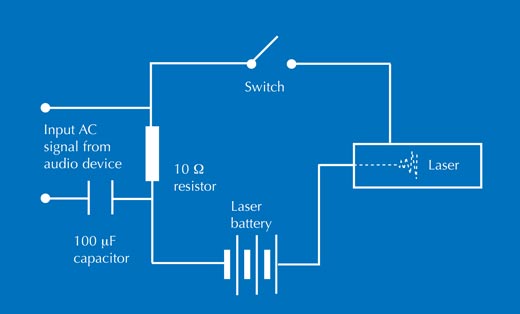
The laser beam, of varying intensity, is sent to a light sensor attached to a mini-amplifier. Because the number of photons reaching the light sensor changes with the frequency of the audio input signal, the current generated by the light sensor also changes with that frequency. This AC signal is sent to the mini-amplifier, causing the cone of the speaker to move – and we can hear the music.
The capacitor in the modulating circuit is essential to let the AC signal through and prevent the batteries’ DC (direct current) from feeding back into the audio device.
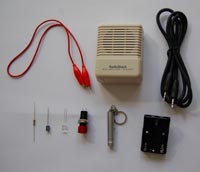
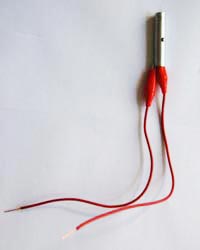
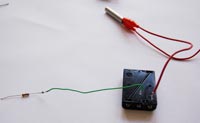
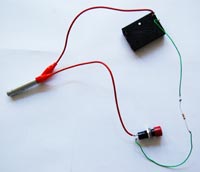
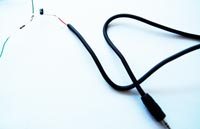
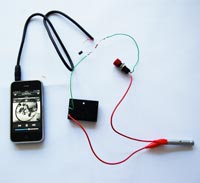
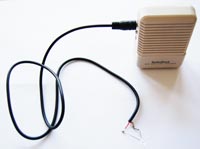
Point the laser beam at the light sensor, aligning them carefully using clamps and stands at both ends.
Switch on the audio device. The music will be played by the mini-amplifier – to which it is transferred via the laser. To make the demonstration even more dramatic, connect the output of the mini-amplifier to a more powerful speaker.
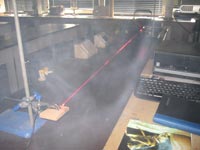
Even relatively small amounts of laser light can lead to permanent eye injuries, so make sure you follow the safety instructions with your laser pen.
So we’d built a great gadget, but what were we going to do with it? My colleagues and I thought the students could design an interactive lecture show – but they came up with a much more creative idea. They decided to write a play based on James Bond, using situations in the play to explain the physics concepts behind our device.
Our Year-12 students wrote an amusing script, full of sound physics and with plenty of audience participation. It was aimed at Year-9 students (ages 13-14), to make them appreciate physics more – and encourage them to consider studying physics at school or even university.

During the course of the play, the older students explained concepts from the GCSE curriculum (ages 14-16), including signal modulation, the visible spectrum as a means of communication, optical fibres and the reflection of light, as well as some more advanced topics such as the photoelectric effect. The script, which can be downloadedw2, is self-explanatory and shows clearly how the concepts were presented.
The students not only performed the play in our own school but also visited other schools in Wales. The audience was impressed by the quality of the play, the students’ knowledge and their ability to transmit it effectively to younger people. The younger students in the audience thought it was a fun way to learn physics and liked the fact that older pupils rather than teachers were showing them these concepts.
The Year-12 students’ attitudes also changed. One girl commented that it was only after she scripted and presented the photoelectric effect to younger students that she started to really understand the phenomenon. This is a common experience for teachers: it is only when we have to teach the topics that we start to understand them thoroughly ourselves. Partly as a result of this project, all of the Year-12 students involved chose to study physics or engineering at university.
The project started in June 2008 but its effects are still being felt. When we visited other schools, our play was not only for the Year-9 students, but also for their teachers. It demonstrated how much physics can be explained with our device; and because we presented them with their very own modulated laser pen, they could do similar demonstrations with their own classes. And of course, my colleagues at Croesyceiliog Schoolw3 continue to use the device in their own lessons.
The impact of the project also extended beyond our region of Wales. In October 2008, together with some of our students, we ran a hands-on workshop for teachers at the Welsh Physics Teachers’ Conference, organised by the UK’s Institute of Physicsw4.
In April 2009, Science Made Simplew5 visited our school and incorporated aspects of our project into their new show for primary and secondary schools, taking our project even further afield – across England and Wales.
The project ran for a whole year, as part of the Rolls-Royce Science Prize 2008-09w6, for which we were one of nine finalists. The research and design stage took a couple of weeks, and the device itself was built in a few days. The theatre phase – writing the script, rehearsing and giving the performances – took about two months. Over the course of the rest of the year, we collaborated with the Institute of Physics and Science Made Simple.
During school hours, we devoted about two months of one-hour lessons (two per week) to the project. The rest of the work was done after school.
Alessio Bernardelli led the project, but it would not have been possible without the help of Matt Smith and John Ivins, colleagues at Croesyceiliog School.
At the time of the project, Matt was an exceptional trainee teacher at Croesyceiliog School. He played an essential role in the design of the circuit, and solved many problems that arose during the course of the project. He is now the director of physics in an international school in Rome, Italy.
John Ivins was a key member of the team thanks to his rapport with the students. He is currently the acting head of physics at Croesyceiliog School in Cwmbran in Wales, UK.
This project is innovative in two main ways. It merges different concepts of physics to produce an alternative use of lasers and then uses a novel pedagogy to facilitate the students’ learning of these topics. The students were given the opportunity to be independent and do their own research, producing an amazing result – they managed to link different aspects of physics (electrical circuits, sound waves, light as a means of communication and the photoelectric effect) and devise a system that actually works! The interesting part is that they didn’t stop at that, but they shared their project in a very original way: drama. Their script is ingeniously adapted to include complex topics in an action story, to explain those concepts in a simpler, entertaining way.
This article is an ideal guideline for hands-on experience, where students are asked to try building the same circuit or variants of it. It would be a great experience for students to ultimately see it functioning. The apparatus can be easily built, due to the circuit diagram and detailed instructions. The equipment required is usually easily found in physics labs or bought in stores at very reasonable prices. The concepts involved are all discussed at A-level standard (ages 16-19), hence students can use this opportunity to apply them to a practical situation.
It is important to show students that physics is not only a set of theories listed under compartmentalised topics, but is also a means of explaining incredible phenomena, and can be enjoyable. This article shows how script-writing and role-playing can help students to better understand the topics and to explain them to younger students while showing them that physics can be a source of enjoyment and satisfaction.
For advanced or intermediate physics students (ages 16-19), the project could be used to explain complex electrical circuits and introduce photoelectricity. For younger students (ages 13-15), the simplified concepts in the play can be used to consolidate the topics already learned and give them an insight into what can be learnt at a more advanced level, stimulating their interest and perhaps encouraging them to continue their studies in physics.
It is interesting to see that when physics is made fun and engaging for students, no matter what age, they are better able to understand even the most difficult concepts. As the authors state, students who were previously struggling with physics improved after taking part in this activity. This is impressive and these sorts of projects should be promoted and encouraged.
Catherine Cutajar, Malta
Script of the play (Word document)
Powerpoint presentation (PPT file)
Download this article as a PDF